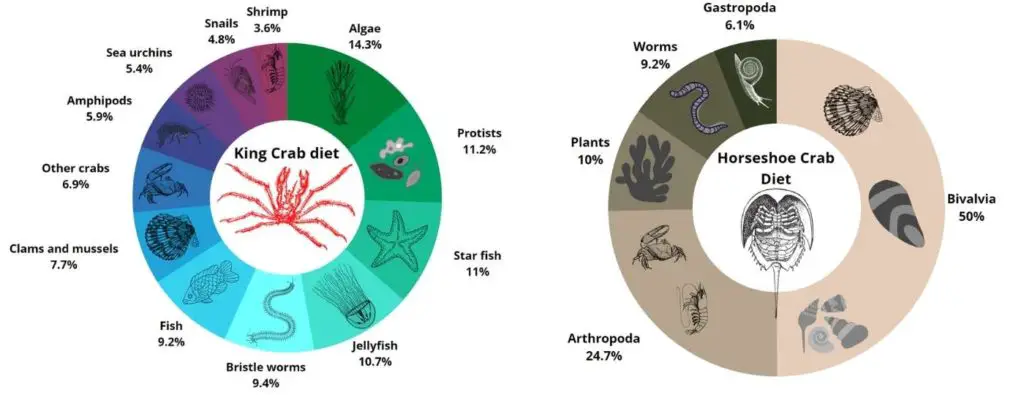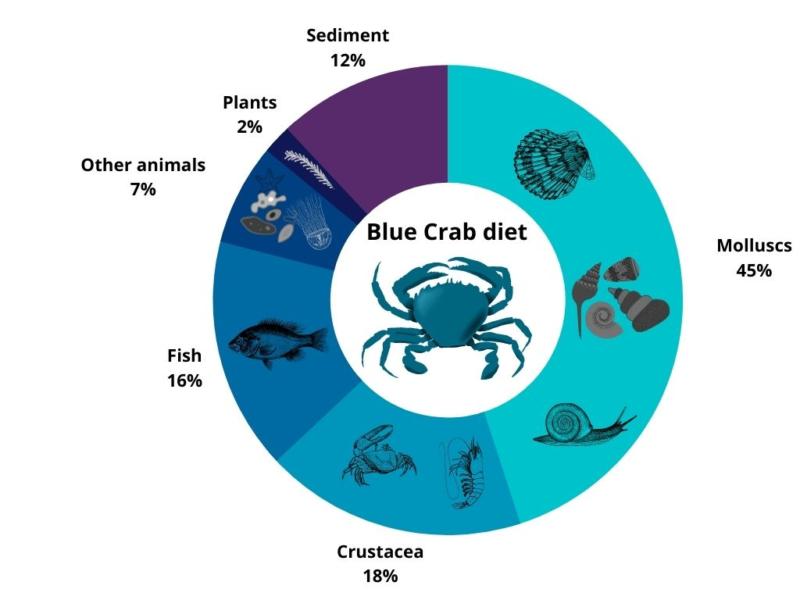As an avid seafood enthusiast and amateur marine life researcher, I’ve always been fascinated by the diverse and intriguing world of crabs.
They’re both delicious and intriguing creatures that can be found in a variety of aquatic environments.
One question I often get asked by fellow seafood lovers is, “Do crabs eat meat?” To answer this question in short:
Yes, crabs do eat meat. However, there’s much more to a crab’s diet and feeding habits than just this simple answer. In this blog post, we’ll dive deeper into the world of crabs and their varied diets.
Contents
A Basic Understanding of Crabs
Before we explore the meat-eating habits of crabs, it’s important to understand a bit more about these fascinating creatures.
Crabs are crustaceans, which means they are part of the same family as lobsters, shrimp, and crayfish.

Crabs are characterized by their hard exoskeleton, five pairs of legs, and two front claws. They can be found in freshwater, saltwater, and even on land, depending on the species.
The Different Types of Crabs and Their Diets
There are over 4,500 species of crabs, and their diets can vary greatly depending on their habitat and specific ecological niche. Here are a few examples of different types of crabs and their feeding habits:
Blue Crab
Blue crabs are found along the Atlantic coast of the United States and are known for their sweet, tender meat.

These crabs are opportunistic feeders, meaning they’ll eat just about anything they can find, including fish, crustaceans, and even plant material.
So yes, blue crabs do eat meat, but they also eat other things as well.
Dungeness Crab
Dungeness crabs, native to the west coast of North America, are also highly sought after for their delicious meat.
They are primarily bottom-dwelling scavengers, feeding on dead or dying organisms, including fish, crustaceans, and mollusks.
As such, Dungeness crabs do eat meat as part of their diet.
Hermit Crab
Hermit crabs are a unique type of crab that inhabit the shells of other marine creatures.
Despite their name, hermit crabs are not true crabs, as they do not have a hard exoskeleton covering their entire body.
These crabs are omnivores and eat a wide variety of foods, including algae, plankton, and small bits of meat from dead organisms.
The Role of Scavenging in a Crab’s Diet
As we’ve seen from the examples above, many crabs are scavengers, meaning they feed on dead or decaying organic matter.
This plays an essential role in the ecosystem, as it helps to break down and recycle nutrients back into the food chain.
Scavenging is also an advantageous feeding strategy for crabs, as it allows them to obtain nutrients from a wide variety of sources.
The Importance of Protein in a Crab’s Diet
Meat, being a rich source of protein, is an important part of many crab species’ diets. Protein is essential for growth and maintaining a healthy exoskeleton, which is crucial for a crab’s survival.
In addition to eating meat, crabs can also obtain protein from other sources, such as algae, plankton, and even other crabs.
A Crab’s Predatory Behavior
While many crabs primarily rely on scavenging for their food, some species exhibit predatory behaviors. For example, the coconut crab, the largest terrestrial arthropod in the world, is known to actively hunt for its food, including birds, rodents, and even other crabs.
Similarly, the green crab is a highly invasive species that preys on various shellfish, causing significant ecological damage in areas where it has been introduced.
My Personal Experience with Crabs
Growing up near the coast, I’ve had the opportunity to observe crabs in their natural habitat and even catch a few myself. From watching them scuttle along the shoreline to seeing them devour a piece of fish, it’s clear that crabs are opportunistic feeders that will eat meat when given the chance.
I’ve also had the pleasure of cooking and eating many different types of crabs, and I can attest to the deliciousness of their meat.
Conclusion
In conclusion, yes, crabs do eat meat.
Their diets vary depending on the species and their habitat, but many crabs are omnivorous and will eat a wide variety of foods, including meat from fish, crustaceans, and other sources.
This protein-rich diet is essential for their growth and survival in the diverse ecosystems they inhabit.
So the next time you enjoy a delicious crab dish, you’ll have a better understanding of the diverse and fascinating diet of these amazing creatures.
FAQs
What does a crab eat?
Crabs are omnivorous and eat a variety of things including algae, plankton, small fish, mollusks, and detritus.
What does small crab eat?
Small crabs typically feed on algae, plankton, small mollusks, and other small marine organisms. Some species may also scavenge on dead animals or consume detritus.
What can crabs not eat?
Crabs should not eat anything that is toxic to them, including chocolate, caffeine, alcohol, citrus fruits, and spicy foods. They should also not be fed anything that is spoiled or rotten.
Is crab and lobster raw in sushi?
No, crab and lobster used in sushi are typically cooked.
Do crabs eat raw meat?
Yes, crabs can eat raw meat. In fact, many species of crabs are scavengers and will consume a variety of meats, both raw and cooked. However, it is important to note that not all types of meat are suitable for crabs and a balanced diet is necessary for their health.
Are crabs carnivores?
Yes, crabs are carnivores as they mainly feed on other animals such as fish, mollusks, and other crustaceans.




